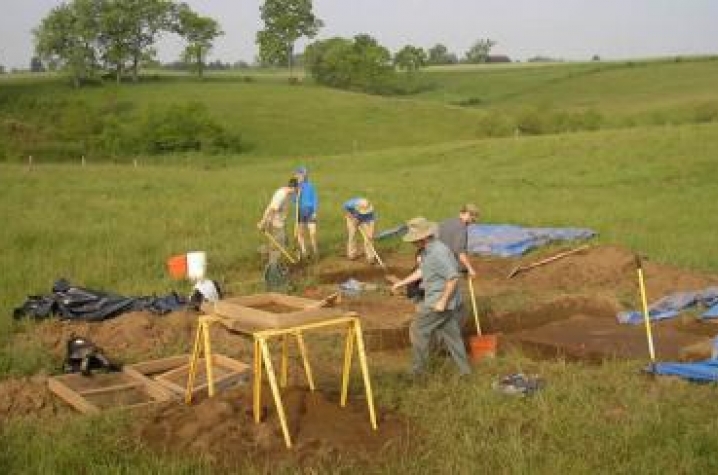Archaeologists, Artists, Educators Collaborate to Share the Story of Lexington's Davis Bottom
LEXINGTON, Ky. (March 31, 2016) — Teachers, parents and schoolchildren in Kentucky and around the world have a new online resource to learn about the history of Lexington’s extraordinary Davis Bottom neighborhood, the “Teaching Through Documentary Art: Lessons for Elementary and Middle School Social Studies Teachers” series.
Inspired by two stunning murals featured in the award-winning documentary “Davis Bottom, Rare History, Valuable Lives,” the innovative lesson plans were developed by archaeologists and educators with the Kentucky Archaeological Survey (KAS), jointly administered by the University of Kentucky’s Department of Anthropology and the Kentucky Heritage Council, and the Davis Bottom History Preservation Project.
Created with Kentucky teachers and homeschooling parents in mind, the 11 stand-alone lesson sets engage social studies students in the fourth through eighth grade level. (However, many adults will find the information fascinating, too.) Not only do students learn about Lexington’s unique multicultural neighborhood at its creation in 1867 and later as a thriving neighborhood in the 1890s, they strengthen visual, literacy and analytical thinking skills. Each “Teaching Through Documentary Art” lesson set consists of a short background essay, standards-based discussion questions, a list of achieved standards, and suggestions for teaching and activities.
Established in the 1860s, Davis Bottom was a residential community located in a valley west of downtown Lexington. Davis Bottom served as a “portal” community for several generations of African-American, European and Appalachian families who moved to the Bluegrass in search of jobs, education and a better quality of life.
The “Teaching Through Documentary Art” website consists of two lesson plans set in the post-Civil War era:
· “Davis Bottom in the 1890s” is a portrait of Kentucky’s working class neighborhood at the turn of the last century. Davis Bottom was one of the city’s first integrated neighborhoods. Learning about the lives of these late 19th century people gives students the opportunity to explore the meaning of neighborhood and the definition of family, the use and abuse of power, and stereotypes about the working poor. The six lesson sets target upper elementary school students (fourth-fifth grades).
· "Civil Rights in Lexington – 4th of July 1867” recreates the scene of one of Kentucky’s largest civil rights events. William “Willard” Davis, the man responsible for establishing Davis Bottom as an integrated community, was among the speakers that day. Learning about this event helps students understand the situation of newly freed African-Americans after the Civil War and the beginnings of their long struggle for civil rights. Five lesson sets target middle school students (sixth-eighth grades).
“These lessons are great examples of the application of the Kentucky Archaeological Survey’s documentary and oral history research in elementary and middle school education (and beyond). Their use of mural-style art to highlight the lives of people in one of Lexington’s first integrated neighborhoods and in early civil rights movements is also very timely,” said Christopher A. Pool, professor and interim chair of the Department of Anthropology of the UK College of Arts and Sciences.
Significant portions of the historic community are impacted now by the construction of the Newtown Pike Extension. The Davis Bottom History Preservation Project was created by a collaborative effort among scholars, educators and residents to document and preserve the history of the tight-knit, working-class neighborhood. Funding for the development of the webpage, lesson plans and artwork was provided by the Kentucky Transportation Cabinet and the Federal Highway Administration as part of the Newtown Pike Extension Project in Lexington.
“In Kentucky, we are fortunate to have individuals in the Kentucky Transportation Cabinet and Kentucky Heritage Council who are willing to work together to explore new ways to make information about Kentucky’s past accessible to grade-school students, their teachers and the public,” said David Pollack, KAS director and adjunct assistant professor in the UK Department of Anthropology. “We at KAS also are fortunate to be able to work with creative people in the private sector, such as those at Voyageur Media Group.”
The artwork, on which the lesson sets were developed, is by documentary artist Susan Walton. Walton’s artwork was featured in the one-hour documentary, “Davis Bottom: Rare History, Valuable Lives,” produced and directed by the Voyager Media Group.
The full Davis Bottom History Preservation Project features four integrated components:
1) the educational website with information, images and other materials, including “Teaching Through Documentary Art” and “Investigating a Shotgun House;”
2) “Davis Bottom: Rare History, Valuable Lives,” distributed by Kentucky Educational Television (KET);
3) “Davis Bottom: Living Memories,” an oral history DVD with resident interviews; and
4) a digital media archive that preserves all of the archival materials used in the project. The Hive at UK College of Arts and Sciences developed the website.
Judy Sizemore, educational consultant with KAS, and A. Gwynn Henderson, education coordinator for KAS, developed the “Teaching Through Documentary Art” educational materials. Henderson, along with UK archaeologist and education colleagues, are currently putting the finishing touches on another series of lessons linked to the Davis Bottom History Preservation Project, “Investigating a Shotgun House,” which will be Case Study 12 in the national Project Archaeology: Investigating Shelter curriculum’s shelter database.
“The synergy of this collaboration has produced what none of us, alone, could have done: award-winning documentaries, lessons, booklets, websites,” Pollack said. “These accomplishments speak to the spirit of the National Historic Preservation Act of 1966. By working and thinking outside the box we have been able to fulfill the promise of this act.”
In 1966, Congress passed the National Historic Preservation Act, which sought to ensure that the nation’s important historic places would be preserved for the future. If the historic places could not be preserved, the act decreed they would be investigated, documented, interpreted and remembered.
“Our collaborations are achieving this for Kentucky's citizens,” Pollack said.
To learn more about archaeology in Kentucky, visit https://youtu.be/dddcYZAOe-M.
MEDIA CONTACT: Gail Hairston, 859-257-3302, gail.hairston@uky.edu










